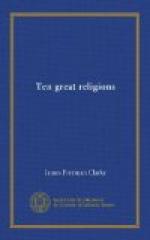But the Aryans were not an exclusively pastoral people; they certainly had barley, and perhaps other cereals, before their dispersion. They possessed the plough, the mill for grinding grain; they had hatchet,[35] hammer, auger. The Aryans were acquainted with several metals, among which were gold, silver, copper, tin. They knew how to spin and weave to some extent; they were acquainted with pottery. How their houses were built we do not know, but they contained doors, windows, and fireplaces. They had cloaks or mantles, they boiled and roasted meat, and certainly used soup. They had lances, swords, the bow and arrow, shields, but not armor. They had family life, some simple laws, games, the dance, and wind instruments. They had the decimal numeration, and their year was of three hundred and sixty days. They worshipped the heaven, earth, sun, fire, water, wind; but there are also plain traces of an earlier monotheism, from which this nature-worship proceeded.
Sec. 4. The Aryans in India. The Native Races. The Vedic Age. Theology of the Vedas.
So far Comparative Philology takes us, and the next step forward brings us to the Vedas, the oldest works in the Hindoo literature, but at least one thousand or fifteen hundred years more recent than the times we have been describing. The Aryans have separated, and the Hindoos are now in India. It is eleven centuries before the time of Alexander. They occupy the region between the Punjaub and the Ganges, and here was accomplished the transition of the Aryans from warlike shepherds into agriculturists and builders of cities.[36]
The last hymns of the Vedas were written (says St. Martin) when they arrived from the Indus at the Ganges, and were building their oldest city, at the confluence of that river with the Jumna. Their complexion was then white, and they call the race whom they conquered, and who afterward were made Soudras, or lowest caste, blacks.[37] The chief gods of the Vedic age were Indra, Varuna, Agni, Savitri, Soma. The first was the god of the atmosphere; the second, of the Ocean of light, or Heaven; the third, of Fire;[38] the fourth, of the Sun; and the fifth, of the Moon. Yama was the god of death. All the powers of nature were personified in turn,—as earth, food, wine, months, seasons, day, night, and dawn. Among all these divinities, Indra and Agni were the chief.[39] But behind this incipient polytheism lurks the original monotheism,—for each of these gods, in turn, becomes the Supreme Being. The universal Deity seems to become apparent, first in one form of nature and then in another. Such is the opinion of Colebrooke, who says that “the ancient Hindoo religion recognizes but one God, not yet sufficiently discriminating the creature from the Creator.” And Max Mueller says: “The hymns celebrate Varuna, Indra, Agni, &c., and each in turn is called supreme. The whole mythology is fluent. The powers of nature become moral beings.”




